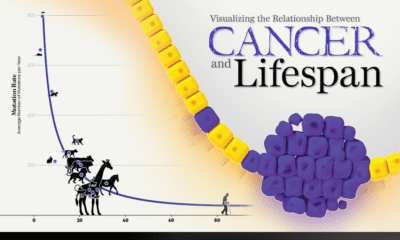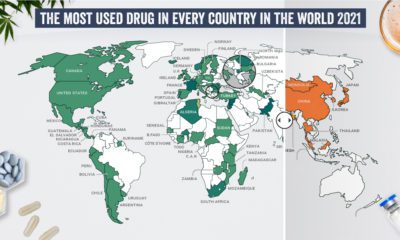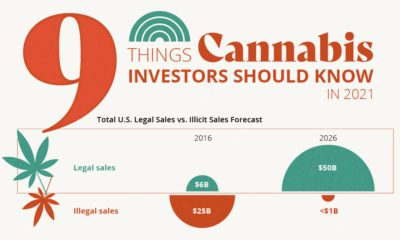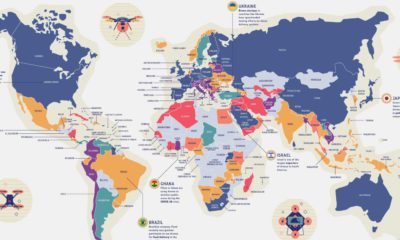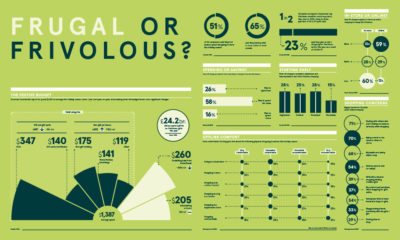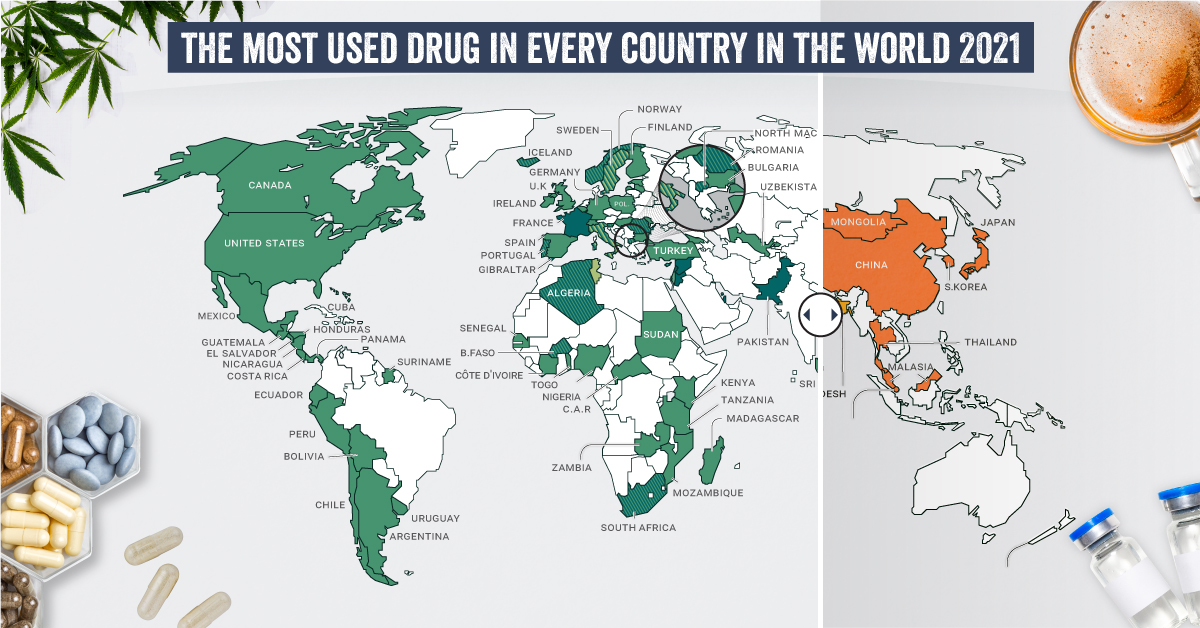Due to their growing list of health benefits, the dominant conversation tends to center around the most abundant cannabinoids—cannabidiol (CBD) and tetrahydrocannabinol (THC). As a result, the cannabinoid market is estimated to reach almost $45 billion by 2024. But CBD and THC are just two cannabinoids out of over a hundred that have been discovered to date. Today’s graphic from Trait Biosciences explores the hidden potential of the lesser-known minor cannabinoids, and illustrates how they fare in comparison to their major counterparts.
Cannabinoids 101
Cannabinoids are chemical compounds found in both hemp and marijuana that mimic compounds found in the human endocannabinoid system. This system is made up of a network of receptors that are involved in physiological processes like mood and memory. When cannabis is consumed, cannabinoids interact with these receptors and produce different effects depending on the receptors they bind to. Although over a hundred cannabinoids have been found, they are not all created equally. They are typically divided into two categories:
Major cannabinoids: More plentiful Minor cannabinoids: Less plentiful
Regardless of whether a cannabinoid is categorized as major or minor, every cannabinoid starts out as a form of CBG.
CBG-A: The Mother of All Cannabinoids
Cannabigerolic acid, or as it is more commonly known, CBG-A, is the acid precursor to other cannabinoid acids such as THC-A, and CBD-A. When the acids are exposed to heat, or prolonged UV light, they convert to neutral cannabinoids such as CBD and THC. While CBG is regarded as a minor cannabinoid, it boasts a wide range of benefits that are urging researchers and scientists to take notice:
Fights inflammation Soothes pain Reduces nausea Slows the spread of cancer cells Helps treat glaucoma
CBG could be hugely beneficial in treating a wide variety of diseases, but it’s just one of many minor cannabinoids that could potentially blow CBD and THC out of the water.
The Potential of Minor Cannabinoids
To date, there has been limited research into the power of minor cannabinoids. However, the results from preliminary research look incredibly promising. Note: Any potential medical treatment listed here stems from preclinical/animal testing only, and is simply intended to illustrate the potential application of each cannabinoid rather than a proven benefit. Scientists also recently discovered two new cannabinoids—THC-P and CBD-P—with research showing that THC-P could potentially be 30 times more potent than THC.
The Future of Minor Cannabinoids
FDA-approved CBD drug Epidiolex has sparked a rising interest in minor cannabinoid trials. In fact, the National Institutes of Health (NIH) has committed to providing funding to strengthen the evidence for minor cannabinoids and their pain relieving properties. Cannabinoids could also add great value to cancer treatment-related side effects, however, more research is needed to turn potential into proof. With the availability of more robust evidence, the potential medical applications for minor cannabinoids could be much greater than we can imagine. on Humans have a storied and complicated relationship with drugs. Defined as chemical substances that cause a change in our physiology or psychology, many drugs are taken medicinally or accepted culturally, like caffeine, nicotine, and alcohol. But many drugs—including medicines and non-medicinal substances taken as drugs—are taken recreationally and can be abused. Each country and people have their own relationship to drugs, with some embracing the use of specific substances while others shun them outright. What are the most common drugs that are considered generally illicit in different parts of the world? Today’s graphics use data from the UN’s World Drug Report 2021 to highlight the most prevalent drug used in each country.
What Types of Common Drugs Are Tracked?
The World Drug Report looks explicitly at the supply and demand of the international illegal drug market, not including commonly legal substances like caffeine and alcohol. Drugs are grouped by class and type, with six main types of drugs found as the most prevalent drugs worldwide.
Cannabis*: Drugs derived from cannabis, including hemp. This category includes marijuana (dried flowers), hashish (resin), and other for various other parts of the plant or derived oils. Cocaine: Drugs derived from the leaves of coca plants. Labeled as either cocaine salts for powder form or crack for cocaine processed with baking soda and water into rock form. Opioids: Includes opiates which are derived directly from the opium poppy plant, including morphine, codeine, and heroin, as well as synthetic alkaloids. Amphetamine-type Stimulants (ATS): Amphetamine and drugs derived from amphetamine, including meth (also known as speed), MDMA, and ecstasy. Sedatives and Tranquilizers: Includes other drugs whose main purpose is to reduce energy, excitement, or anxiety, as well as drugs used primarily to initiate or help with sleep (also called hypnotics). Solvents and Inhalants: Gases or chemicals that can cause intoxication but are not intended to be drugs, including fuels, glues, and other industrial substances.
The report also tracked the prevalence of hallucinogens—psychoactive drugs which strongly affect the mind and cause a “trip”—but no hallucinogens ranked as the most prevalent drug in any one country. *Editor’s note: Recreational cannabis is legal in five countries, and some non-federal jurisdictions (i.e. states). However, in the context of this report, it was included because it is still widely illicit in most countries globally.
The Most Prevalent Drug in Each Country
According to the report, 275 million people used drugs worldwide in 2020. Between the ages of 15–64, around 5.5% of the global population used drugs at least once. Many countries grouped different types of the same drug class together, and a few like Saudi Arabia and North Macedonia had multiple different drug types listed as the most prevalent. But across the board, cannabis was the most commonly prevalent drug used in 107 listed countries and territories: How prevalent is cannabis worldwide? 72 locations or more than two-thirds of those reporting listed cannabis as the most prevalent drug. Unsurprisingly these include countries that have legalized recreational cannabis: Canada, Georgia, Mexico, South Africa, and Uruguay.
How Common Are Opioids and Other Drugs?
Though the global prevalence of cannabis is unsurprising, especially as it becomes legalized and accepted in more countries, other drugs also have strong footholds. Opioids (14 locations) were the most prevalent drugs in the Middle-East, South and Central Asia, including in India and Iran. Notably, Afghanistan is the world’s largest producer of opium, supplying more than 90% of illicit heroin globally. Amphetamine-type drugs (9 locations) were the third-most common drugs overall, mainly in East Asia. Methamphetamine was the reported most prevalent drug in China, South Korea, and Japan, while amphetamine was only the most common drug in Bangladesh. However, it’s important to note that illicit drug usage is tough to track. Asian countries where cannabis is less frequently found (or reported) might understate its usage. At the same time, the opioid epidemic in the U.S. and Canada reflects high opioid usage in the West. As some drugs become more widespread and others face a renewed “war,” the landscape is certain to shift over the next few years.
